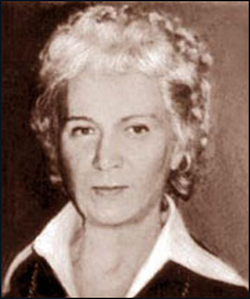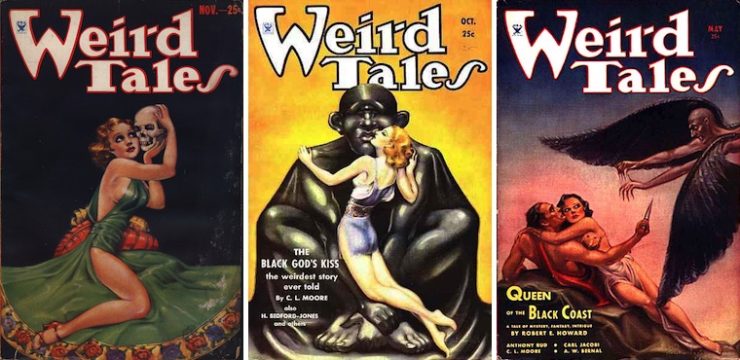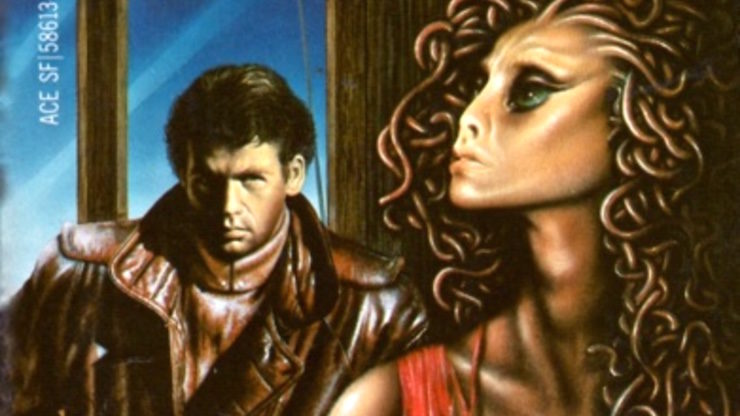In this bi-weekly series reviewing classic science fiction and fantasy books, Alan Brown looks at the front lines and frontiers of the field; books about soldiers and spacers, scientists and engineers, explorers and adventurers. Stories full of what Shakespeare used to refer to as “alarums and excursions”: battles, chases, clashes, and the stuff of excitement.
There was a day when magazine racks were far larger than they are today, and choices were far more varied. If you wanted science fiction adventure, you could read Planet Stories or Amazing Stories. If you wanted stories with science and rivets, you could read Astounding Science Fiction. For Earthbound adventures you could read Doc Savage Magazine, Argosy, or Blue Book. And if you wanted horror stories, your first choice was Weird Tales. The stories in that magazine ranged from the pure horror of H. P. Lovecraft and the barbarian tales of Robert E. Howard to the planetary adventures of C. L. Moore, and her protagonist Northwest Smith. But while the adventures of Northwest Smith might bear a superficial resemblance to those you would find in Planet Stories, there were darker themes lurking beneath the surface.
Recently, I reviewed some of Leigh Brackett’s tales of Eric John Stark, a hard-bitten adventurer scrapping to survive in the savage underbelly of a civilization that spanned the Solar System while searching out riches and adventure. At first glance, Northwest Smith seems cut from that same mold, but there is a distinct difference between these characters. Stark generally faced threats that he could fight his way out of, whether it be with ray gun or sword. The threats that Northwest Smith faces are of a more existential nature—it is not just his life on the line, it’s his very soul. There are dangers and mysteries in the Stark stories, but there are flat-out horrors to be faced in the Smith stories, alongside frequently sexual undertones as well. The difference is rooted in the house styles of the magazines where these stories appeared; Stark’s in Planet Stories, with Smith’s in Weird Tales.
I first encountered the Northwest Smith story “Shambleau” in anthologies back when I was a young teenager. The story presented itself as the truth behind the legend of Medusa, and centered on a creature whose horror was counterbalanced by the ecstasy she brought her victims. The prose was evocative, the pace of the story was relentless, the hair on my neck stood up while I read it, and I remembered the tale for years. At that point in my life, having grown up surrounded by brothers, I was attracted to and fearful of girls in equal measure. I saw other boys happy when dating, but miserable when things didn’t go well, which made me afraid to approach girls myself. “Shambleau” captured the spirit of that adolescent ambivalence perfectly, at the same time as it amplified those emotions for dramatic effect.
When I found a more complete paperback collection of Northwest Smith’s adventures in the 1980s, I remembered the power of that one story, and bought the collection immediately. In all of the stories, I found the writing to be as powerful as I remembered. But it was full of terrors and nightmares; not a book to read alone, late at night. In the end, I was glad I hadn’t encountered all of Northwest Smith’s adventures at a young age, because I might have been scarred for life.
About the Author
 Catherine Lucille Moore (1911-1987), who wrote as C. L. Moore, was a major author in the early days of science fiction, and also wrote fantasy and horror tales. Like many other women of the time, she took on a gender-neutral pen name. She was married to the prolific author Henry Kuttner, who is not widely remembered today, partially because his own frequent use of pen names made it difficult for readers to know just what work was his.
Catherine Lucille Moore (1911-1987), who wrote as C. L. Moore, was a major author in the early days of science fiction, and also wrote fantasy and horror tales. Like many other women of the time, she took on a gender-neutral pen name. She was married to the prolific author Henry Kuttner, who is not widely remembered today, partially because his own frequent use of pen names made it difficult for readers to know just what work was his.
Moore is famous for creating two adventurers who appeared in Weird Tales. The first was Northwest Smith. The second was Jirel of Jorey, a female ruler and warrior from the Middle Ages who often face supernatural threats, and was notable among the predominately male protagonists of the time. Either of these characters would be enough to secure her a place in SF history; when combined with her other tales, and her collaborations with her husband, the whole represents a quite impressive and varied body of work.
With Kuttner, Moore wrote under several pen names, including Lewis Padgett. Under this name, she was co-author of one of the most powerful SF stories I ever read, “Mimsy Were the Borogroves,” a story that wrapped together time travel, Lewis Carrol’s Alice’s Adventures in Wonderland, a set of educational toys from the future, and young children, in which horrified parents find that their offspring are becoming something incomprehensibly more than human.
[As a side note, one thing I’ve often wondered is whether young George Lucas ever read C. L. Moore. I’ve never found anyone who stated definitively that the name “Northwest Smith” inspired the moniker Indiana Jones, but to me, the parallels between the names, and even some of their adventures, are too striking to ignore.]
Weird Tales Magazine

Weird Tales was one of the first magazines to focus exclusively on fantasy, horror, and science fiction. Founded in 1923, it became a market for many writers who went on to become mainstays of genre fiction. These included H.P. Lovecraft, Clark Ashton Smith, Robert E. Howard, Edmund Hamilton, C. L. Moore, Henry Kuttner, Robert Bloch, and many others. There was a collegial relationship between the writers, with many corresponding, collaborating, and offering advice to one another. The stories spanned what would now be considered a wide range of sub-genres: ghost stories, gothic horror, sword and sorcery, high fantasy, planetary romance, and science fiction. In fact, because it was here we first saw Howard’s Conan stories, Weird Tales could be argued to be the birthplace of the sword and sorcery genre. In general, there was a dark tone to many of the stories, with malevolent evil and monsters lurking around every corner. The censorship of the time limited the amount of sex that could appear, but many of the stories were heavy with innuendo and suggestive themes.
The covers of Weird Tales were distinctive as well, and often lurid, with artist Margaret Brundage providing most of the cover illustrations during the magazine’s heyday in the 1930s. Her work frequently featured nearly nude women, covered just enough to escape censorship. It was rumored that authors would include nude scenes in their stories in hopes of getting featured on the cover. Another popular artist, specializing more in action-oriented illustrations, was fantasy art pioneer J. Allen St. John, and noted pen and ink illustrator Virgil Finlay got his start providing interior art for the magazine.
Weird Tales ceased regular publication in the 1950s, during the period in which many pulp magazines folded up shop. It has appeared sporadically since then, mostly in the hands of fans of the pulp era, who produce new issues as a labor of love.
Northwest Smith

The adventures of Northwest Smith are evocative tales that defy easy summarization. I can give you the bones of the plots, but their real magic lies in the prose itself, and Moore’s lurid descriptions of horrors, marvels, gods and demons. There are similarities between many of the tales, and more than a few hinge on Smith’s attraction to a beautiful woman, but each of these stories is unique, with its own twist on the many perils lurking around every corner of the Solar System. Smith himself is a tough-as-nails pilot and smuggler, dressed in leather, and always with a heat- or ray gun strapped to his hip. While the reader discerns a code of honor in his actions, it is a loose code that does not prevent him from committing theft and violence in pursuit of wealth. His closest companion is the shifty Venusian Yarol, who is even more amoral than Smith.
The book opens with “Shambleau,” Smith’s most famous adventure. Smith encounters an exotic young woman being attacked by a crowd in a Martian bazaar, and instinctively draws his heat gun to protect her. The tale pivots on his ignorance of the legend of Shambleau, which is its one flaw, as he is a man knowledgeable in the ways of the world(s), and should know better. Smith gives her shelter in his apartment, finds himself attracted and repelled by her in equal measure, and begins having strange, powerfully ecstatic dreams. The prose is evocative, drawing you into Smith’s viewpoint, and Moore’s portrayal owes more to legends of a succubus than a Medusa. By the time Smith sees the girl’s wormlike hair fully revealed and realizes that she is sapping his health for her sustenance, he has been drawn in too deeply and is unable to resist. Only the chance intervention of his friend Yarol saves him from a horrible fate. The story is at once an analogy for sexual desire and drug addiction.
“Black Thirst” finds Smith on Venus, again confronted by a beautiful woman in need. But this time, the beautiful courtesan hires him to protect her from the man who runs her harem, where women have been disappearing. The man, however, turns out to be a creature from an ancient race who has grown tired of devouring female beauty, and wants a taste of Smith. The only path to safety is through a nightmare realm of horror, where Smith must face challenges that make his gunfighting skills pale in comparison.
In “The Tree of Life,” Smith is pinned down in an ancient ruin on Mars, contemplating his imminent capture by the Patrol. He finds a beautiful dark-haired woman who asks him for help returning to the Tree of Life. They find an image of a tree cast by the shadows of a grating, and to his surprise she disappears into these shadows. Hearing his pursuers, he runs after her, and finds himself transported to a lush landscape. The woman is a priestess of Thag, and takes him to her people. Smith soon finds out that the Tree of Life is an aspect of Thag, who is older than any civilization on Mars—and that the woman brought him here to feed her ruler. Only his fierce determination can rescue him from this fate.
In the “Scarlet Dream,” a patterned crimson scarf, purchased in a Martian bazaar, provides a portal to another plane of existence. Smith encounters a girl with golden-orange hair in a field of strangely animated grass. She takes him to her house, they become lovers, and he is content for a time. She says there is only one way out of her world, and that is to utter a word engraved on the wall of their Temple, which brings death to the person who utters it. He finds the people of this strange land are sustained by blood, provided by their Temple. Despite this knowledge, he dwells happily with the girl until his restless nature becomes too great to bear, and in the end, she sacrifices herself by uttering the word so that he can return home.
At this point, just as the reader starts to suspect that all of Smith’s adventures begin with a mysterious woman, “Dust of the Gods” comes along, with Smith and Yarol dead broke in a Martian dive bar, and a mysterious man offering them some well-paying but dangerous work. He says it involves the dust of Black Pharol, an ancient god from the Lost Planet, who to most men still exists only as an empty curse. The two take the job and fly to an ancient city, where they find a cave haunted by pale phantasms, and then encounter wonders beyond imagination. Again, the prose sweeps the reader away into a land of horrors and marvels.
“Lost Paradise,” is set on Earth, among the huge steel towers and arching bridges of New York. Smith and Yarol see an old man, who Yarol suspects is from a lost race that resides in Mongolia. Another man steals a package from the old-timer, who calls out for help, promising “anything” in exchange for assistance. This warms the cockles of Yarol’s mercenary heart—he leaps to assist, and soon returns with the package. The price Yarol asks for is not money. Instead, he wants to know the secret of the man’s race. He and Smith find themselves wrapped up in the stranger’s story to the point where time itself bends, and soon they know more than they ever wanted to about the man’s race and the tragedy of their lost home.
Smith finds himself in a ruined city on Venus in “Julhi,” with no idea how he got there. A young woman, Apri, tells him that he is to be sacrificed to followers of the sorceress whose name gives the story its title. But Julhi is more than just a sorcerer, more than human, and soon Smith is again swept away to worlds he barely understands. If Shambleau was a menacing flame, Julhi is a roaring bonfire, and Smith will be lucky to survive this encounter—and must commit a heinous act to block her evil plans.
In “The Cold Grey God,” Smith is back on Mars, hired by a beautiful and formerly famous singer to steal an object. But when he brings it to her, he finds that she doesn’t just want to hire him temporarily: she wants to steal his very body for her own use, destroying his own consciousness in the process.
“Yvala” takes Smith and Yarol to the thick jungles of an unnamed moon of Jupiter, sent by a man to bring back one of the beautiful women who reportedly live there. But while they find great beauty and temptations that put those of the ancient sirens to shame, there is great evil there, and only Smith’s indomitable will can save them.
All of the stories in this collection were written in the 1930s except one, “Song in a Minor Key,” written two decades later. Smith is back on Earth, but cannot enjoy its beauty without remembering the act of violence that started him on his lawless career. The tale serves as a wistful epilogue for the series.
Final Thoughts
C.L. Moore was an outstanding and evocative writer, easily one of the best who wrote in the early days of science fiction. She was also a master of horror writing, drawing the reader into the story and its emotions. She is fondly remembered today, albeit by too few people. Moore deserves wider recognition, and should be celebrated as one of the leading voices in genre fiction. Northwest Smith stands as one of the many memorable characters she created in her career. And now I turn the floor over to you. Have you read Northwest Smith or any of the other works by C. L. Moore? Did you experience the same horrors that I did? Not being a regular reader of horror fiction, I would welcome input from those who have read more of it. And if you would like to, please offer your thoughts on Weird Tales magazine and its impact on science fiction.
Alan Brown has been a science fiction fan for over five decades, especially fiction that deals with science, military matters, exploration and adventure.










